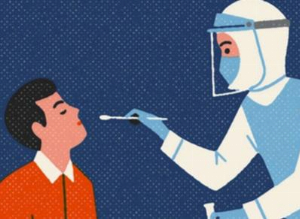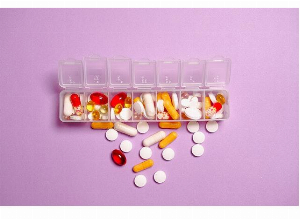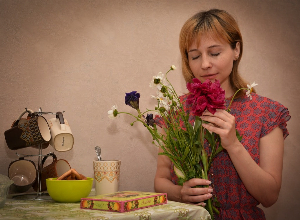How to get tested for the coronavirus (COVID-19)?
Published Sep 3, 2020 • Updated Oct 23, 2020 • By Candice Salomé
Faced with the upsurge in confirmed cases of coronavirus (COVID-19), more and more private labs and testing centers are now offering testing. At present, it is estimated by the Johns Hopkins Coronavirus Resource Center that almost 700,000 tests are carried out every day across the US.
But what are the different types of tests on offer? How do they differ? Who can be tested? How is the test carried out?
We tell you everything in our article!

Who should be tested for COVID-19?
As of August 24, 2020, the CDC recommends seeking a COVID-19 test for:
- People who are exhibiting COVID-19 symptoms (fever, continuous cough, new loss of smell or taste, etc.)
- People who have had close contact (within 6 feet of an infected person for at least 15 minutes) with someone with confirmed COVID-19
- People who have been asked or referred to get testing by their healthcare provider, local or state health department, should get tested.
COVID-19 tests are available at no cost nationwide at health centers and select pharmacies. The Families First Coronavirus Response Act ensures that COVID-19 testing is free to anyone in the U.S., including the uninsured.
PCR test, antibody test, RDT… What are the different types of coronavirus (COVID-19) test? How do they work?
Coronavirus tests make it possible to take care of infected people, to break the chain of transmission by isolating the sick, but also to control the evolution of the pandemic.
There are two types of tests:
- Viral tests (RT-PCR): they make it possible to determine whether a person is a carrier of the coronavirus at the time of the test. It is carried out by nasal swab.
- Antibody tests: are used to determine whether a person has developed an immune reaction after having been in contact with the virus. This test detects the presence of antibodies through a blood sample.
RT-PCR tests:
To carry out this test, a swab is inserted far enough into the nose of the patient to reach the area called the "nasopharynx" to collect secretions.
Laboratory analysis can then identify the presence of Sars-CoV-2 in the sample. It cannot be misidentified as another coronavirus.
The RT-PCR test must be carried out by a doctor, nurse, pharmacist, or other healthcare professional. They may also be done at home using a home-collection kit, which must be prescribed or ordered from a health professional. Depending on the test provider, results should be available same day (some locations) or up to a week.
Unfortunately, false negative results are possible if the sample is taken at the wrong time. This is because Sars-CoV-2 is only temporarily present in the nasopharynx area. This varies according to the clinical signs and the course of the infection.
As Blaise Kamendje, a public health doctor on assignment to the dedicated coronavirus unit within the Regional Health Agency in Centre-Val de Loire in France, explains: "If you look too early, you won't find it, and if you look too late, you risk not finding it. There is a window of opportunity which is most optimal on the 7th and 8th days after the onset of symptoms".
Antibody tests:
Antibody tests are designed to look for traces of the virus in the body. When the body is attacked by a disease-causing agent (in this case Sars CoV-2), the body produces immunoglobulins (antibodies) to defend itself. These antibodies make it possible to eliminate the virus, heal and generally develop immunity.
These tests make it possible to find out whether a person has been in contact with the disease.
The antibody test consists of a blood test in a testing center or lab. The blood is then spun in a centrifuge and a biologist analyses the serum (where antibodies are present). Depending on the test provider, results should be available same day (many locations) or 1-3 days.
There are different types of antibody tests:
- ELISA tests (enzyme-linked immunosorbent assay) carried out in a medical lab,
- Rapid diagnostic tests (RDT or antigen tests) performed by a doctor, nurse or pharmacist.
ELISA tests:
This test makes it possible to tell whether the patient has been in contact with the virus and has therefore developed antibodies. To date, science has not yet been able to determine whether patients with antibodies are immune to reinfection. Official cases of reinfection are, for the time being, rare.
According to Professor Arnaud Fontanet of the Pasteur Institute, the problem with these tests is that they still have a high rate of false-positives, at around 5%.
RDT (antigen) tests:
RDT tests consist in placing a drop of blood taken from the fingertip on a strip that changes color depending on the test result.
These tests do not determine whether the person is contagious or not, but only reveal the presence of specific antibodies to the virus.
These tests are carried out by a doctor, a nurse or pharmacist.
These tests can be analyzed at the doctor's office or clinic where the sample is collected and results may be available in minutes.
Saliva tests:
As patients are often wary of needles involved in the blood draws for RT-PCR testing, many teams around the world have tried to develop a testing method using saliva samples (and therefore involving little or no pain).
The FDA recently approved a new saliva-based COVID-19 test developed by researchers at the Yale School of Public Health. The simpler, less expensive, and less invasive test is becoming immediately available to diagnostic laboratories and should be largely available in the coming weeks.
Where to get tested?
COVID-19 tests are available nationwide at health centers and select pharmacies. Additional testing sites may also be available in your area.
You can visit your state or local health department’s website to look for the latest local information on testing. It is advised that you call your healthcare provider first if you have symptoms of COVID-19 and want to get tested.
- You can consult your state or territorial health department website here.
- You can search for your local health department here.
The U.S. Department of Health & Human Services has also compiled a list of community-based testing sites.
What to do after being tested at COVID-19?
If the result is positive:
A positive result means you had coronavirus when the test was done. If your test is positive, you should stay home and self-isolate.
- Stay home and away from others except to get medical care
- As much as possible, stay in a specific room and away from other people in your home. If you need to be around other people at home, wear a mask.
- Monitor your health - follow care instructions from your healthcare provider and local health department
- Look for emergency warning signs for COVID-19 (trouble breathing, persistent pain or pressure in the chest, new confusion, inability to wake or stay awake, bluish lips or face). If you or someone else is showing any of these signs, call 911 or call ahead to your local emergency facility.
- Call ahead before visiting your doctor - call ahead, many medical visits for routine care are being postponed or done by phone or telehealth.
- Rigorously follow the barrier gestures.
- You can be around others after:
- 24 hours with no fever, and
- Respiratory symptoms have improved (e.g., cough, shortness of breath), and
- 10 days since symptoms first appeared
If you tested positive for COVID-19 but had no symptoms, you can be with others after 10 days have passed since you had a positive viral test for COVID-19.
If you test positive for COVID-19, someone from the health department may contact you to check on your health, discuss who you have been around, and ask where you have spent time while you may have been able to spread COVID-19 to others. This is called contact tracing. It is important to trace close recent contacts to inform those who may be at risk, reduce the spread of the infection, and potentially save lives.
If the result is negative:
A negative result means the test did not find coronavirus. The test result only means that you did not have COVID-19 at the time of testing. In this case, there are two scenarios:
- People experiencing COVID-19 symptoms
- People who have been in contact with a sick person.
If you are still having COVID-19 symptoms but have tested negative, you should still continue to take steps to protect yourself (follow the barrier gestures and respect a period of isolation until at least 10 days since your symptoms first appeared).
If you've been in close contact (within 6 feet for at least 15 minutes) of someone who has COVID-19:
- You should stay home for 14 days after your last contact with a person who has COVID-19
- Watch for fever (100.4°F), cough, shortness of breath, or other symptoms of COVID-19
- Stay away from others
If the result is unclear, void, borderline or inconclusive
An unclear, void, borderline or inconclusive results means that it's impossible to say if you had coronavirus at the time of the test. In this case, you should get another test done as soon as possible.
If you had the test done because you were exhibiting symptoms, you should continue self-isolating and get another test within 5 days of the first signs of symptoms.
Was this article helpful to you?
Share your thoughts and questions in the comments!
Take care!
Sources :
https://coronavirus.jhu.edu/testing/individual-states
https://www.cdc.gov/coronavirus/2019-ncov/symptoms-testing/testing.html
https://www.fda.gov/consumers/consumer-updates/coronavirus-testing-basics
https://news.yale.edu/2020/08/15/yales-rapid-covid-19-saliva-test-receives-fda-emergency-use-authorization
https://www.cdc.gov/publichealthgateway/healthdirectories/healthdepartments.html
https://www.naccho.org/membership/lhd-directory
https://www.hhs.gov/coronavirus/community-based-testing-sites/index.html
https://www.cdc.gov/coronavirus/2019-ncov/daily-life-coping/contact-tracing.html
https://www.cdc.gov/coronavirus/2019-ncov/if-you-are-sick/quarantine.html
Comments
You will also like

What are the dangers associated with the over-the-counter sale of certain medicines?
Dec 19, 2020 • 6 comments

 Facebook
Facebook Twitter
Twitter

